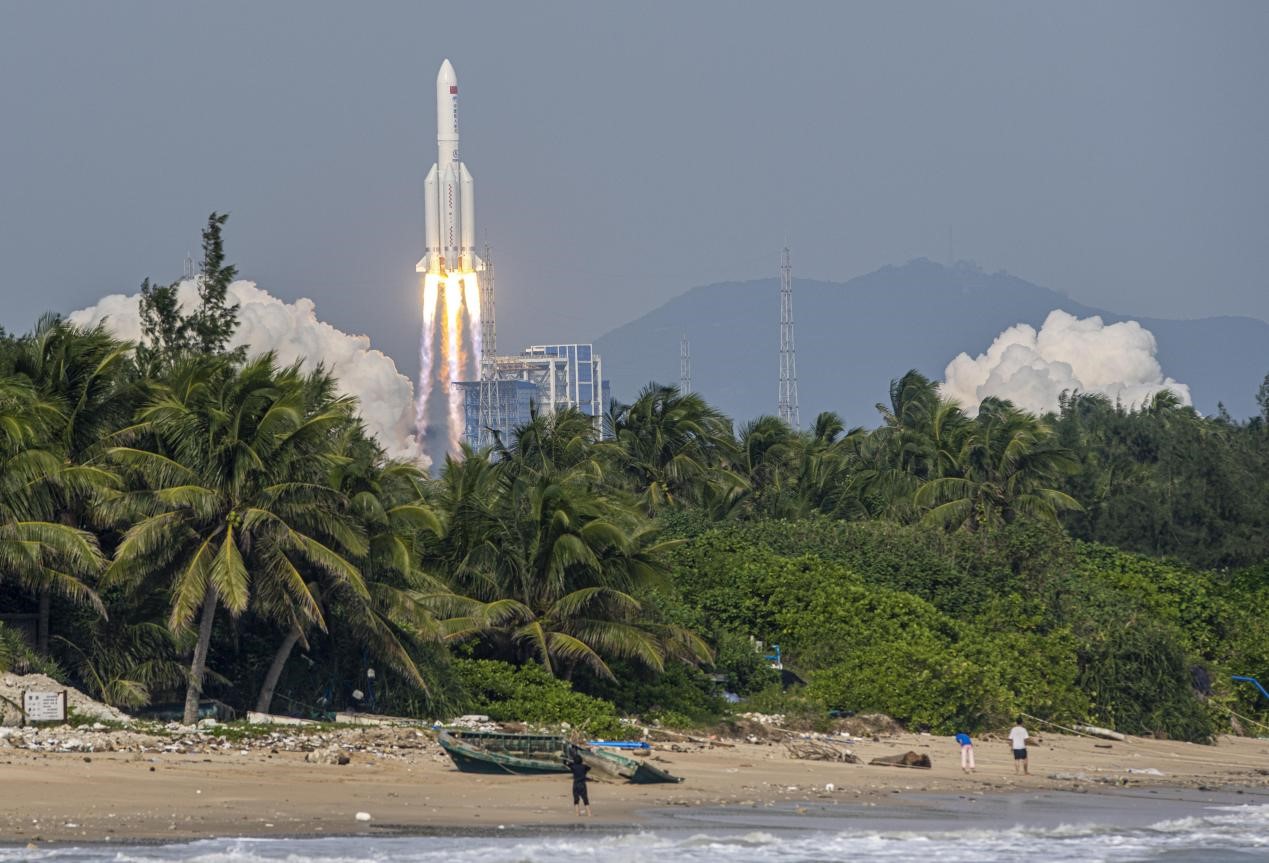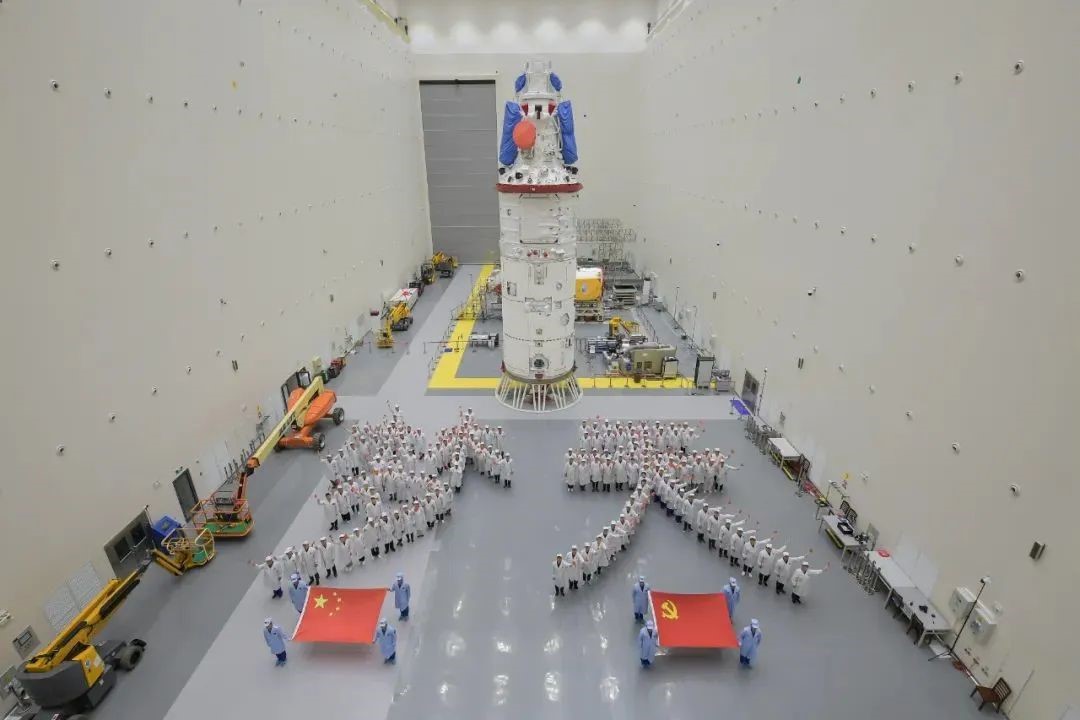China's Mengtian module docks with space station combination
The Mengtian lab module successfully docked with the front port of Tianhe, the core module of China's Tiangong space station at 4:27 a.m. on Nov. 1 after it entered the planned orbit, according to the China Manned Space Agency (CMSA).

A Long March-5B Y4 carrier rocket, carrying the space lab module Mengtian, blasts off from the Wenchang Spacecraft Launch Site in south China's Hainan province at 15:37, Oct. 31, 2022. (Photo by Yuan Chen/People's Daily Online)
The whole process of rendezvous and docking took about 13 hours.
The lab module was launched by a Long March-5B Y4 carrier rocket from the Wenchang Spacecraft Launch Site on the coast of the southern island province of Hainan on Oct. 31.
Mengtian will conduct transposition as planned and then form the space station's basic configuration in T-shape together with Tianhe core module and Wentian lab module. It is a key step toward the completion of the space station.
According to an expert with the China Aerospace Science and Technology Corporation, the Mengtian lab module is so far the heaviest payload launched by China to date. The rocket fairing of the Long March-5B Y4 was "custom-made" based on the shape and weight of the Mengtian.
For instance, to enable wireless communication during the ascent stage, a wave-transparent window was designed on the fairing.
Su Lei, chief designer of the control system of the Long March-5B rocket family, told People's Daily that carrier rocket is capable to achieve accurate rendezvous and docking within a limited period. Besides, the control system of the rockets can also automatically calculate the deviation and correct it to ensure the accuracy of orbit injection, rendezvous and docking.

A simulation image of the docking between the Mengtian module and China's space station. (Photo from the China National Space Administration)
The Mengtian lab is one of the three modules forming the basic T-shape configuration of China's space station and the second lab module after the Wentian lab. It consists of four sections: working cabin, cargo airlock cabin, payload cabin, and resource cabin.
The 17.88-meter-long new module has a takeoff mass of about 23 tons and a diameter of 4.2 meters. It is mainly used for space science experiments.
The design team of the Mengtian module innovatively equipped the space lab with a cargo airlock cabin that facilitates the ins and outs of cargo and payloads. With its payload transfer device, the cargo airlock cabin is able to handle cargo as heavy as 400 kilograms, and the size of the cargo envelope for a single shipment can reach 1.15 meters x 1.2 meters x 0.9 meters.
To allow the entry and exit of larger and heavier cargos, Mengtian has been installed with a 1.2-meter-wide port gate to the airlock cabin, with which astronauts can finish outboard operation of cargos and payloads just in the cabin without extravehicular spacesuits.

The development team of the Mengtian module poses for a picture with the space lab. (Photo from the China National Space Administration)
The airlock cabin of the Mengtian module will better help astronauts carry out efficient and safe extravehicular experiments, and further improve the scientific ability of China's space station, said an expert.
Building an advanced national space lab is the goal of the construction of the Tiangong space station. The Mengtian module has the most powerful payload-supporting capabilities among the three modules.
Liu Guoning, deputy chief designer of the scientific cabinet system at the Chinese Academy of Sciences (CAS)' Technology and Engineering Center for Space Utilization, introduced that the Mengtian lab mainly focuses on microgravity studies.
Carrying eight science experiment cabinets, Mengtian can carry out scientific research on materials science, fluid physics and combustion science, which is expected to make scientific results at an international level.
Some 40 scientific experimental projects in these fields have been scheduled so far, Liu revealed.
Besides, among Mengtian's payloads, there is also a cabinet with the ability to film - for the first time in a space station - material changes in high temperatures with X-rays. It is a device of historic significance, said Liu Xuechao, chief designer of the experiment system of the cabinet and a researcher with the Shanghai Institute of Ceramics of the CAS.
Photos
Related Stories
- Chinese astronauts give lecture from space station lab module
- China to livestream class from space station lab module
- Transposition of China's space station lab module completed
- Transposition of China's space station lab module completed
- Airshow China set to exhibit space station combination replica
- China's space station lab module Mengtian arrives at launch site
- Science lab's journey from cargo ship to Earth's orbit
- Why is Chinese the only language used on China's space station?
- Chinese vice premier congratulates Wentian mission participants
- China successfully launches Wentian lab module, construction of China’s space station enters full speed stage
Copyright © 2022 People's Daily Online. All Rights Reserved.









